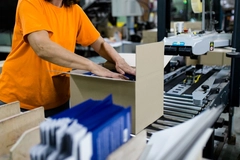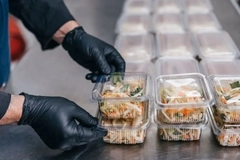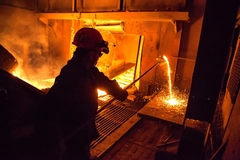Dow, WestRock and Nexus establish circular economy for hard-to-recycle plastics in US Hefty EnergyBag program

03 Mar 2021 --- Reynolds Consumer Products’ Hefty EnergyBag program has diverted more than two million pounds of hard-to-recycle plastics from landfills in the US. This year, Cobb County, a suburb of Atlanta, Georgia, is partnering WestRock and Nexus to collect 100 tons of typically unrecyclable plastics through a local Hefty EnergyBag program.
Dow and Keep Cobb Beautiful launched the program in Cobb County in 2018, collecting hard-to-recycle plastics at curbside and converting them into valued resources, including fuel, park benches, composite decking and concrete blocks.
During the last year, materials collected through the Cobb County program by WestRock Recycling have been used to create chemical feedstocks for new food-grade plastic through the program’s local end-market partner, Nexus Fuels.
PackagingInsights explores the program with Jesus Atias, North America sustainability manager at Dow Packaging & Specialty Plastics, Nathan Nelson, general manager at WestRock and Jeff Gold, Nexus CEO.
Value chain unification
Dow introduced Reynolds Consumer Products to the Hefty EnergyBag concept and continues to advance the program by identifying pilot communities and potential end-market applications.
The material science company also provides grant money and financial program starter kits and collaborates in technical trials.
“The [two million pounds] milestone shows the program is helping divert valuable resources from landfills, reduce dependence on fossil fuels, increase efficiency at recycling facilities and improve the quality of other recycled materials,” notes Atias. Reynolds’ Hefty EnergyBag program has diverted more than two million pounds of hard-to-recycle plastics from landfills.
Reynolds’ Hefty EnergyBag program has diverted more than two million pounds of hard-to-recycle plastics from landfills.
“After the Hefty EnergyBag orange bags have been picked up by one of the participating haulers (American Disposal, B Green Services, Custom Disposal Service and Pickers Waste Service), they are sent to WestRock where they’re sorted, baled and sent to an approved end market,” explains Nelson.
The approved destinations include Nexus, as well as qualification trials at developing end markets.
“Once the Hefty EnergyBag orange bags are separated at WestRock, we receive the hard-to-recycle plastics, converting them into feedstocks for plastics production through thermal depolymerization (pyrolysis),” adds Gold.
Decontaminated recycling streams
Nexus uses the pyrolysis liquid produced from the collected plastics to create new, food-grade quality plastic.
“We can break the plastic down to its molecular form. Those molecules are just simple building blocks used to make new packaging or other products in any form,” Gold continues.
“They are chemically and physically identical to the original molecules used in the production cycle and are perfectly fine to use in any application where plastics are used.”
The materials Nexus processes are not mechanically-recyclable and typically have no value in the current recycled materials market.
“Some of the material we process, like grocery bags and other plastic film, can cause problems with regular recycling equipment and are removed from processing lines whenever possible and later landfilled,” highlights Gold.
Nexus works with municipal recycling facilities to allow all the materials found in household recycling streams to be managed effectively. The participating haulers are American Disposal, B Green Services, Custom Disposal Service and Pickers Waste Service.
The participating haulers are American Disposal, B Green Services, Custom Disposal Service and Pickers Waste Service.
For Nelson, one of the program’s most significant successes is reducing plastic film and other plastic materials that cannot be recycled via curbside at the WestRock facility.
“This has a direct impact on improving operations, reducing unplanned shutdowns and maintenance, and improving quality for other recycled commodities.”
“Contamination is an issue we continue to work with our other program partners to address so more collected materials can be processed.”
Chemical recycling concerns
Greenpeace USA recently warned many American Chemistry Council-approved “chemical” or “advanced” recycling projects are unviable or misleadingly promoted as recycling when they mainly produce fuels and waxes.
Although this criticism cannot be aimed at Nexus and its food-grade recycled plastic, there are concerns chemical recycling is high energy-intensive at a time of rising global temperatures.
“Like any industrial process, our process requires energy to work,” says Gold. “However, the difference here is the energy we consume to produce feedstocks is far lower than that required to produce the same feedstock from crude oil or even natural gas, considering extraction, transport, and processing.”
“We are taking a product – plastic – that has already gone through all the purification and processing steps to create a clean, uniform material, and simply taking it back to its original molecular form.” The program’s orange collection bags make it easy for recycling facilities to separate the materials they cannot process.
The program’s orange collection bags make it easy for recycling facilities to separate the materials they cannot process.
“When done efficiently, this process consumes much less energy than making a new product and uses a valuable resource that might otherwise be placed into a landfill or worse, find its way into our waterways and oceans.”
Meanwhile, Dow views the Hefty EnergyBag program as “one tool in the kit” to capture the value of used plastics and keep more waste out of landfills.
“[Advanced recycling] is one part of creating a circular economy, which also includes making plastics more easily recyclable, finding more end uses for recycled plastics, making it easy for consumers to understand how to recycle and expanding access to recycling collection systems to the approximately 40 percent of US households that don’t have access to curbside recycling programs,” Atias explains.
“There’s no single solution to optimize recycling and end plastic waste. Mechanical recycling should be used whenever possible, with advanced recycling processes and programs to complement it as necessary.”
Circular-by-design
Dow recently launched its first post-consumer recycled (PCR)-rich resin for collation shrink film in North America, demonstrating the viability of recycled plastics in F&B packaging.
“The new resin was designed with 70 percent recycled material and 30 percent virgin resin and can be used by our customers to create final film applications with up to 40 percent PCR content,” outlines Atias.
“Innovations like this and the Hefty EnergyBag program are part of our efforts to design products for circularity and implement circular solutions to provide new life for used plastics.”
A point on paper
Meanwhile, WestRock’s focus remains on paper – “the original green packaging,” Nelson says. The packaging supplier’s paper packaging is made with renewable virgin fiber sourced from responsibly managed forests.
“We actively promote efforts to increase the amount of land certified to recognized forest management standards and have created one of the largest chain-of-custody certified fiber procurement organizations in the industry,” he points out.
“We also have one of the industry’s largest recycling networks and reuse fiber-based packaging to manufacture various new paperboard and 100 percent recycled products.”
“We believe the most sustainable approach to fiber sourcing is one that balances virgin and recycled materials. When it comes to recycling, it’s important all materials work together – from paper to glass to plastics – to ensure a recycling solution that works for everyone.” Dow launched its first PCR-rich resin for collation shrink film in North America last year.
Dow launched its first PCR-rich resin for collation shrink film in North America last year.
Calling on consumers
Atias is confident consumers want to be part of the plastic waste solution while the Hefty EnergyBag program has reported strong interest in participating communities. Consumer engagement remains pivotal to the program’s success.
“We work with Reynolds Consumer Products to provide local program partners with communications and marketing tools to help them increase awareness participation in the program and the strategic, operational support to run these programs effectively,” Atias indicates.
“Through continued community outreach with our local partners, residents become more familiar with the Hefty EnergyBag program, and contamination declines so more of the collected material can be processed by our end-market partners.”
The Hefty EnergyBag program’s signature bright orange collection bags make it easy for recycling facilities to separate and forward the materials they cannot process, preventing contamination of other recycling streams.
“Our local program partners do a great job of educating the community and continuing to engage residents,” Gold adds. “This program gives residents a clear role in advancing recycling and being a part of the overall solution to a sustainable future.”
“This program provides a role for everyone in a truly circular economy – starting with the consumer all the way to the end market and the renewed materials,” concludes Nelson.
By Joshua Poole











